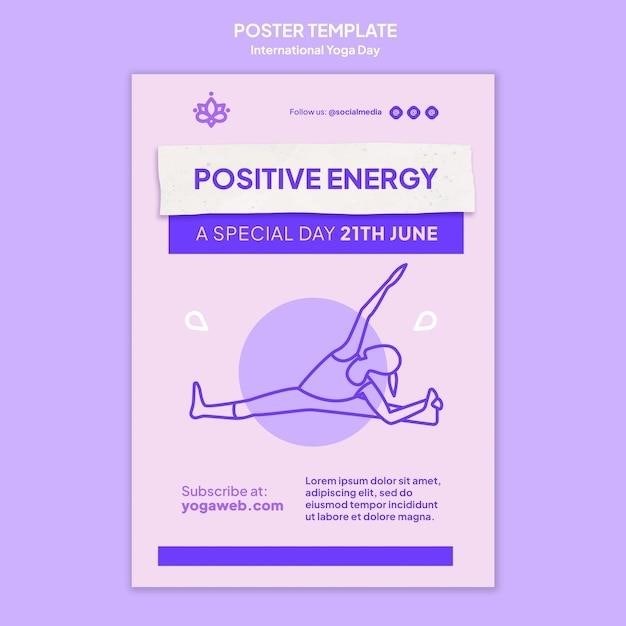Rotator Cuff Tendinitis Exercises⁚ A Comprehensive Guide
This comprehensive guide provides a detailed overview of rotator cuff tendinitis exercises, encompassing range of motion, strengthening, and stretching routines. It delves into the importance of exercise in recovery, outlines a sample exercise program, and offers essential tips for safe and effective execution. Moreover, it addresses precautions and considerations to ensure optimal results and minimize the risk of further injury.
Introduction
Rotator cuff tendinitis, also known as shoulder impingement syndrome, is a common condition that affects the tendons of the muscles surrounding the shoulder joint. It occurs when these tendons become inflamed or irritated, often due to overuse, repetitive motions, or injury. The pain associated with rotator cuff tendinitis can significantly impact daily activities, making it difficult to perform simple tasks such as reaching overhead, lifting objects, or even sleeping comfortably. While rest and medication can help manage the symptoms, exercise plays a crucial role in the rehabilitation process, promoting healing, restoring range of motion, and strengthening the shoulder muscles. This guide will explore the importance of exercise in rotator cuff tendinitis recovery, provide a comprehensive overview of different types of exercises, and offer a sample program to help you regain function and reduce pain.
Understanding Rotator Cuff Tendinitis
The rotator cuff is a group of four muscles and their tendons that surround the shoulder joint, providing stability and allowing for a wide range of motion; When these tendons become inflamed or irritated, it’s known as rotator cuff tendinitis. This condition commonly arises from repetitive overhead activities, such as throwing, swimming, or playing tennis. It can also be caused by sudden injuries, such as falls or direct blows to the shoulder. Over time, the inflammation can lead to pain, stiffness, and weakness in the shoulder. The pain often worsens with overhead activities, and it can radiate down the arm. Rotator cuff tendinitis is particularly prevalent in individuals who engage in physically demanding occupations or participate in sports that involve repetitive overhead movements. Understanding the nature and causes of rotator cuff tendinitis is essential for developing an effective treatment plan, including the use of exercise therapy.
Importance of Exercise in Rotator Cuff Tendinitis Recovery
Exercise plays a pivotal role in the recovery and management of rotator cuff tendinitis. It helps to reduce pain, improve range of motion, strengthen the surrounding muscles, and promote overall shoulder function. Regular exercise can help to restore the normal mechanics of the shoulder joint, reduce inflammation, and improve blood flow to the affected area. Strengthening exercises target the rotator cuff muscles and surrounding muscles, enhancing their ability to support the shoulder joint and prevent further injury. Stretching exercises improve flexibility and range of motion, reducing stiffness and allowing for greater mobility. By increasing the strength and flexibility of the shoulder muscles, exercise helps to reduce the strain on the inflamed tendons, promoting healing and reducing pain; Furthermore, exercise can help to prevent future episodes of rotator cuff tendinitis by improving overall shoulder health and stability.
Types of Rotator Cuff Tendinitis Exercises
A comprehensive rotator cuff tendinitis exercise program encompasses a variety of exercises designed to address different aspects of shoulder function and recovery. These exercises are typically categorized into three main types⁚ range of motion exercises, strengthening exercises, and stretching exercises. Range of motion exercises aim to restore and improve the movement of the shoulder joint. Strengthening exercises focus on building the strength of the rotator cuff muscles and surrounding muscles, which help to stabilize the shoulder joint and prevent further injury. Stretching exercises are designed to increase flexibility and range of motion, reducing stiffness and improving overall shoulder function. The specific exercises included in a rotator cuff tendinitis program will vary depending on the individual’s condition, pain levels, and progress. It is essential to consult with a physical therapist or other healthcare professional to develop a personalized exercise plan that is appropriate for your specific needs.
Range of Motion Exercises
Range of motion exercises play a crucial role in rotator cuff tendinitis rehabilitation by restoring and improving the movement of the shoulder joint. These exercises are typically performed in a controlled manner, gradually increasing the range of motion as pain and inflammation subside. Examples of common range of motion exercises include shoulder shrugs, arm circles (forward and backward), and pendulum swings. Shoulder shrugs involve gently raising and lowering the shoulders, while arm circles involve making small, controlled circles with the affected arm. Pendulum swings involve leaning forward and allowing the arm to hang freely, then gently swinging it in a circular motion. These exercises help to increase flexibility, reduce stiffness, and improve overall shoulder function. It is essential to perform range of motion exercises regularly and to stop if you experience any pain or discomfort.
Strengthening Exercises
Strengthening exercises are an integral part of rotator cuff tendinitis rehabilitation, focusing on building muscle strength and endurance in the shoulder joint. These exercises target the muscles that support and stabilize the shoulder, helping to prevent further injury and improve overall function. Common strengthening exercises include external and internal rotation, shoulder abduction, and rows. External rotation exercises involve rotating the arm outward away from the body, while internal rotation exercises involve rotating the arm inward towards the body. Shoulder abduction exercises involve lifting the arm away from the body to the side, while rows involve pulling the arm back towards the body. These exercises can be performed using resistance bands, weights, or simply body weight. It is essential to start with light weights or resistance and gradually increase the intensity as strength improves. Performing strengthening exercises regularly and correctly is crucial for optimal recovery and long-term shoulder health.
Stretching Exercises
Stretching exercises are an essential component of rotator cuff tendinitis rehabilitation, aimed at improving flexibility and range of motion in the shoulder joint. These exercises help to lengthen and loosen tight muscles around the shoulder, reducing pain and stiffness, and promoting optimal function. Common stretching exercises include cross-body shoulder stretch, shoulder external rotation stretch, and overhead shoulder stretch. The cross-body shoulder stretch involves bringing one arm across the body and gently pressing it towards the chest, while the shoulder external rotation stretch involves holding the arm at a 90-degree angle and rotating it outward. The overhead shoulder stretch involves reaching one arm overhead and gently pulling it towards the opposite ear. It’s crucial to perform stretching exercises slowly and gently, avoiding any sharp or sudden movements that could aggravate the injury. Holding each stretch for 15-30 seconds and repeating it several times a day can enhance flexibility and promote healing.
Sample Rotator Cuff Tendinitis Exercise Program
This sample exercise program provides a structured approach to rotator cuff tendinitis rehabilitation, incorporating a range of exercises designed to improve strength, flexibility, and overall shoulder function. It’s crucial to consult with a physical therapist or healthcare professional before starting any exercise program, as they can personalize it based on your specific needs and limitations. The program typically involves three sets of each exercise, starting with 5 repetitions and gradually increasing to 15 repetitions as tolerated. It’s important to listen to your body and stop if you experience any pain. This sample program includes⁚
- Warm-up⁚ Gentle shoulder rotations and arm circles for 5-10 minutes.
- Range of motion exercises⁚ Pendulum swings, arm circles, and shoulder shrugs.
- Strengthening exercises⁚ External and internal rotations with a light dumbbell or resistance band, wall slides, and shoulder presses.
- Stretching exercises⁚ Cross-body shoulder stretch, shoulder external rotation stretch, and overhead shoulder stretch.
- Cool-down⁚ Gentle shoulder stretches and light arm circles for 5-10 minutes.
This sample program is a starting point and may be modified based on your individual progress and pain levels. Regularly performing these exercises can contribute to effective rotator cuff tendinitis recovery and long-term shoulder health.
Tips for Performing Rotator Cuff Tendinitis Exercises
Proper technique and adherence to these tips are crucial for maximizing the benefits of rotator cuff tendinitis exercises while minimizing the risk of further injury.
- Start slowly and gradually increase intensity⁚ Begin with a few repetitions of each exercise and gradually increase the number as you feel stronger;
- Listen to your body⁚ If you experience pain, stop the exercise immediately. Pain is a signal that you are pushing too hard.
- Maintain proper form⁚ Focus on performing each exercise with correct technique. Avoid any jerky movements or straining.
- Use appropriate resistance⁚ Start with light weights or resistance bands and gradually increase the resistance as your strength improves.
- Breathe deeply⁚ Consciously inhale and exhale during each exercise. This helps to improve circulation and reduce muscle tension.
- Stay consistent⁚ Aim to perform your exercises regularly, ideally 3-4 times per week. Consistency is key to seeing results.
- Warm up and cool down⁚ Before starting your exercises, warm up your muscles with gentle shoulder rotations and arm circles. After completing your exercises, cool down with gentle stretches.
- Seek professional guidance⁚ If you are unsure about proper technique or have any concerns, consult with a physical therapist or healthcare professional.

By following these tips, you can enhance your rotator cuff tendinitis recovery process and promote long-term shoulder health.
Precautions and Considerations
While rotator cuff tendinitis exercises are generally safe and effective, it’s essential to be mindful of certain precautions and considerations to ensure a smooth and successful recovery.
- Pain management⁚ If you experience significant pain during exercises, stop immediately and consult with your doctor or physical therapist. Pain is a signal that you are pushing too hard;
- Rest⁚ Allow adequate rest between exercise sessions and between sets. Overdoing it can lead to further injury.
- Proper warm-up and cool-down⁚ A thorough warm-up before exercises and a cool-down afterward are crucial for preparing your muscles and preventing injury.
- Avoid strenuous activities⁚ Avoid activities that aggravate your shoulder pain. Gradually increase the intensity of your activities as your shoulder strengthens.
- Seek professional guidance⁚ If you have any concerns about your exercises or experience persistent pain, consult with a physical therapist or healthcare professional for personalized advice.
- Individualized approach⁚ Remember that everyone’s recovery journey is unique. What works for one person may not work for another. It’s important to tailor your exercises to your specific needs and limitations.
By adhering to these precautions and considerations, you can minimize the risk of setbacks and promote a successful rotator cuff tendinitis recovery.
Rotator cuff tendinitis exercises play a pivotal role in restoring function, reducing pain, and promoting long-term recovery. By incorporating range of motion, strengthening, and stretching routines into your daily regimen, you can effectively address the underlying causes of rotator cuff tendinitis and regain full shoulder mobility. Remember to prioritize proper form, listen to your body, and seek professional guidance when needed.
Consistency is key. Regular exercise helps build muscle strength, improve flexibility, and enhance overall shoulder stability. While the initial stages of recovery may require patience and persistence, the rewards of a healthy and functional shoulder are well worth the effort. Through a well-structured exercise program and a commitment to rehabilitation, you can overcome rotator cuff tendinitis and return to an active lifestyle.
Remember, this guide provides a general framework for rotator cuff tendinitis exercises. Consult with a physical therapist or healthcare professional for a personalized program tailored to your specific needs and condition.
